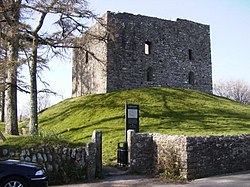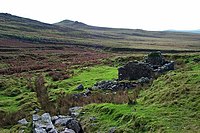Lydford
| Lydford | |
| Devon | |
|---|---|
 Lydford Castle | |
| Location | |
| Grid reference: | SX512850 |
| Location: | 50°38’44"N, 4°6’22"W |
| Data | |
| Population: | 394 (2001) |
| Post town: | Okehampton |
| Postcode: | EX20 |
| Dialling code: | 01822 |
| Local Government | |
| Council: | West Devon |
| Parliamentary constituency: |
Torridge and West Devon |
Lydford is a village, once an important town, in Devon situated six miles north of Tavistock on the western fringe of Dartmoor.
The village stands above the small River Lyd, which courses through a deep, narrow gorge. The gorge is crossed by a bridge of single span; and at a little distance a tributary stream forms a cascade in an exquisite glen.
The village is noted for Lydford Gorge, the town's interesting history and for the beauties of the surrounding countryside, all making it a popular place with visitors. From its Perpendicular church of St Petrock fine views of the Dartmoor tors are seen.
The parish of Lydford is immense, embracing some 50,000 acres of land. Close to the church are slight remains of the castle of Lydford.
Running south west from the village is Lydford Gorge, a 1½-mile wooded gorge which has been cut through the slate rock by the River Lyd. The gorge area is owned by the National Trust[1]. The gorge is rich in nature and the course of its rivers has several breathtaking features, including "the Devil's Cauldron" and the 100 foot White Lady Waterfall.
Contents
Name of the village
The original Old English name for the village was Hlidaford or Hlydanford, of unknown origin.
History
Quiet and agricultural as Lydford is today, it was once a major borough and an economic centre.
The village was established as a new burh, one of the four which King Alfred established in Devon. It first appears in recorded history in 997, when the Danes made a plundering expedition up the Tamar and Tavy as far as Hlidaford. The attack is described in the following passage from the Anglo-Saxon Chronicle:
- Her on ðissum geare ferde se here abutan Defenanscire into Sæfern muðan and þær heregodan ægðer ge on Cornwealum and on Norðwealum and on Defenum, and eodon him þa up æt Wecedport and þær micel yfel worhton on bærnette and on mannslihtum, and æfter þam wendon eft abutan Penwiðsteort on þa suðhealfe and wendon þa into Tamer muðan and eodon þa up oð hi comon to Hlydanforda, and ælc þing bærndon and slogon þe hi gemitton, and Ordulfes mynster Tæfingstoc forbærndon and unasecgendlice herehyðe mid him to scypon brohton.[2]
- In this year, the army (the Vikings) fared to Devonshire and the Bristol Channel, pillaging amongst the Cornish, Devonians and Welsh. They went to Watchet, and there wrought much evil by burning and slaughter, and afterwards they went about Land's End to the south and up into the Tamar's mouth and went up it until they came to Lydford, and burnt and slew anything they found, and burned down Ordwulf's monastery at Tavistock, and unspeakably brought plunder with them to their ships.
During the reign of Ethelred II, there was a mint, and coins minted there were inscribed LVD., LVDA, and LVDAN. In the reign of Edward the Confessor, Lydford was the most populous centre in Devonshire after Exeter, but the Domesday Survey relates that forty houses had been laid waste since the Conquest, and the town never recovered its former prosperity.
Under the Normans, according to the Domesday Book, Lydford was taxed equally with London, giving an idea of its significance at the time, though also because the parish of Lydford embraced the entirety of the Forest of Dartmoor under the Normans (as it did until the 20th century). The parish being so broad, parishioners from across more or less the entirety of Dartmoor were brought to Lydford for burial until the 12th century. The path used to make this final journey is known as the 'Lych way'. A local legend tells of phantom monks in white and phantom funeral processions seen walking along the Lych Way.[3]
A gild at Lideford is mentioned in 1180, and the pipe roll of 1195 records a grant for the reestablishment of the market. The castle is first mentioned in 1216, and thenceforth it was the heart of the town. In 1216 the castle was granted to William Briwere, and was shortly afterwards fixed as the prison of the stannaries and the meeting-place of the Forest Courts of Dartmoor.
In 1238 the borough, which had hitherto been crown demesne, was bestowed by Henry III on Richard, earl of Cornwall, who in 1268 obtained a grant of a Wednesday market and a three days fair at the feast of St Petrock. The borough had a separate coroner and bailiff in 1275, but it was never incorporated by charter, and only once, in 1300, did it return members to parliament.
During the English Civil War, Lydford was the haunt of the then notorious Gubbins Band, a gang of ruthless cut-throats and highwaymen, who took advantage of the turmoil of the times to ply their villainy. According to one account of the time:
- Gubbins-land is a Scythia within England, and they pure heathens therein. Their language is the drosse of the dregs of the vulgar Devonian, They hold together like burrs: offend one and all will avenge their quarrel.
In 1987 the parish of Lydford finally lost its claim to be the largest parish in England. It was split into two civil parishes; Lydford and Dartmoor Forest[4]. The ecclesiastical parish has also been split, with Princetown made a separate parish, though joined together with other parishes in the West Devon Benefices.[5]
Lydford Church
The first Christian church in Lydford was a wooden structure built around the year 650 and probably burnt down by the Vikings in their raid of 997. The dedication of the parish church to St Petrock would suggest a foundation by King Athelstan, who favoured Cornish and Welsh saints, or an earlier Cornish settlement in the town.
The church was later rebuilt in the perpendicular gothic style, and although ostensibly Norman, some of the architectural furniture, for example the font, were of the Anglo-Saxon style (or at latest, early Norman), thus it would appear that the church was rebuilt upon the site of the earlier building.
The church was enlarged in the 13th century, the tower being added in the 15th century. A further enlargement occurred c. 1890 with the addition of the vestry and northern aisle.
Lydford Castle and Lydford law
Two castles have been built at Lydford, the first immediately in the wake of the Norman Conquest in 1066.
The second castle was built on the site of the first castle in about 1132, a 3-storey tower commanding a strategic view over much of the surrounding countryside, and was eminently defensible, with Lydford Gorge on one side, and the land sloping steeply away from it.
Under King Edward I the castle became the Stannary prison. Its reputation was not good. Sir Richard Grenville used the prison as an oubliette for his political opponents. An order of Parliament during the reign of Henry VIII describes the prison in 1512 as: one of the most hanious, contagious and detestable places in the realm, and Lydford Law was a by-word for injustice. Lydford Castle was also one of the seats of the Bloody Assizes of Judge Jeffreys.
The prison is commemorated in the poem Lydford Law by the Tavistock poet William Browne:
- I've often hear of Lydford law,
- How in the morn they hang and draw,
- And sit in judgement after
In the time of Cromwell, the castle was entirely in ruins, but in the 18th century it was restored and again used as a prison and as the meeting-place of the manor and borough courts. The site is now maintained by English Heritage[6], and entry is free of charge.
Sources and outside links
- Lydford village website
- Lydford Parish Council website
- Lydford Castle and Saxon Town - official site at English Heritage
References
- ↑ National Trust, 2004. "Lydford Gorge."
- ↑ Worcester Chronicle, 997
- ↑ Hippisley Coxe, Anthony E. (1973). Haunted Britain. Pub. Hutchinson. ISBN 0-09-116540-7. P. 30.
- ↑ Lydford Parish Council website
- ↑ Diocese of Exeter: parish profile, Princetown
- ↑ Palmer, D.W., 2004. "Lydford Castle."
